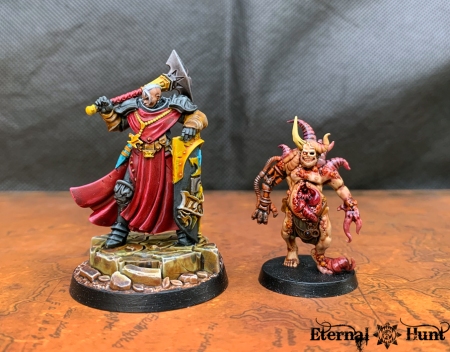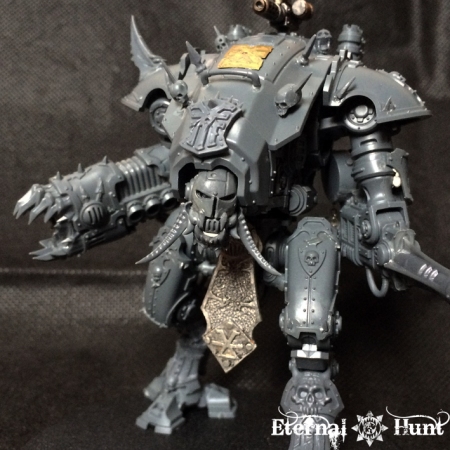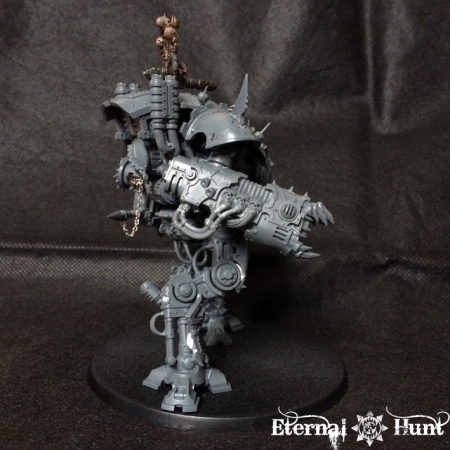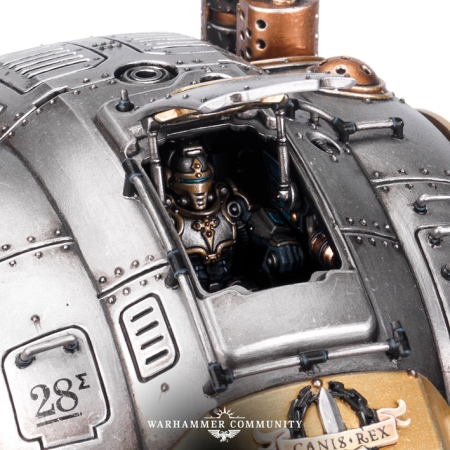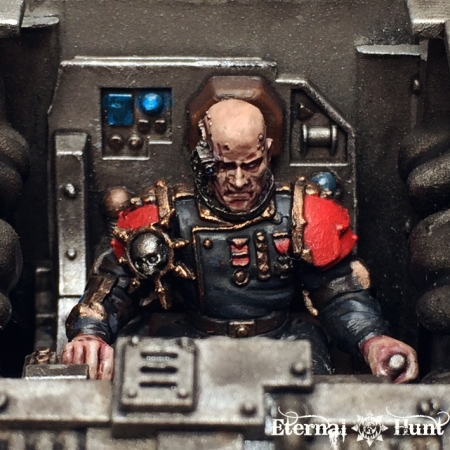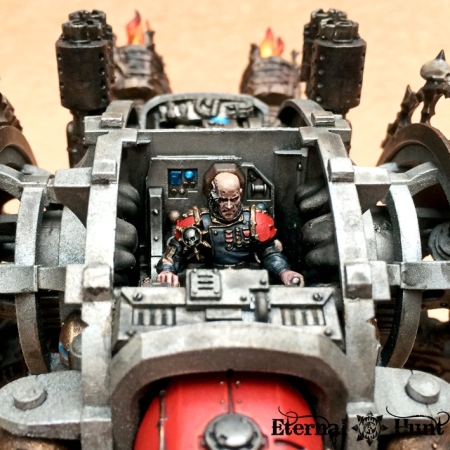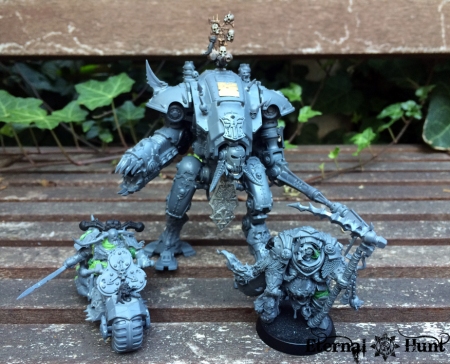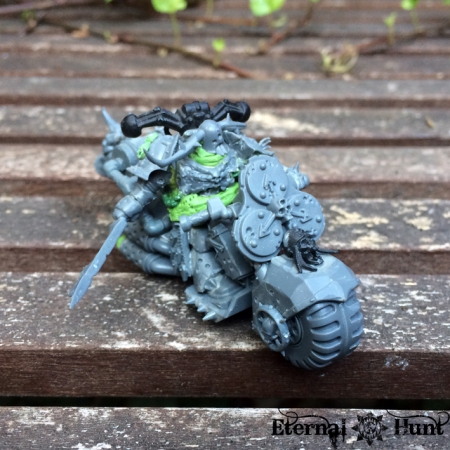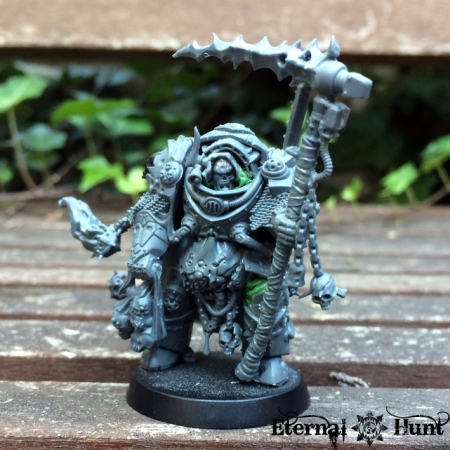
Hey everyone: Once again, sorry for the lack of updates. I returned from my recent trip to Amsterdam full of new hobby ideas — it’s just the sitting down and writing about it part where I seem to falter. It has also been getting harder and harder to get feedback on my posts recently, which makes it all the more tempting to actually build and paint stuff instead of blogging about it…
Be that as it may, here’s another post at long last. And while today’s update started out as a regular (if very late) review of models that come with the Dark Imperium boxed set, it has warped and mutated into something slightly different for a number of reasons: I realised early that I would need to divide my look at the box in two parts, for one. For talking about the Primaris Space Marines will invariably mean taking a look at their implications for the overall setting, both from a modeling and storytelling perspective. And seeing the additional kits they have been receiving recently, that would make for a pretty sizeable post in and of itself.
At the same time, there’s also the fact that I have been bitten by the Nurgle bug on account of the new Death Guard models, and have started to play around with the new sprues. So for today, let us take a closer look at the chaotic side of the Dark Imperium release: The New Death Guard models, designed by Maxime Pastourel and Aly Morrison:

By now, it’s no longer a secret that Maxime Pastourel, aka Morbäck, is not only one of GW’s sculptors, but also one of the people behind one of the best hobby blogs on the internet, and also the owner of what’s probably the best Nurgle army in existence, the Plaguebones. The army was even featured recently on the Warhammer Community page, yet I would argue that you should really head over to Maxime’s own blog for the bigger picture.
Anyway, back when the first teasers of the new Death Guard models surfaced, I literally made a little squee of delight when I discovered more and more telltale elements of Maxime’s Nurgle conversions both in the artwork and the actual models: I was basically only waiting for him to finally make some Death Guard models, and now they are finally here. And I am more than happy with the outcome! What’s more, I’ve managed to get my hand on most of the Dark Imperium Death Guard models, courtesy of fellow hobbyist BubblesMcBub (cheers, mate!). So let’s take a look at the models and at what I have done so far with some of them.
Oh, and once again, the review over at Convert Or Die should make for some excellent complementary reading — just pointing this out before we get going 😉
Lord of Contagion

What a beast! I probably have this semi-conscious shortlist of what a Nurglite warlord should be in the back of my head, and this guy really ticks all of the boxes for me: Massive? Check! Clad in ancient, pitted Terminator armour? Check. Intestines squelching out of the collapsed parts in the armour? Check! Wielding a massive, vicious close combat weapon? Check, check and check!
It’s really cool how close the Lord of Contagion comes to basically embodying the archetypal warlord of Nurgle — to wit, it’s probably no coincidence that he resembles this iconic piece of artwork, courtesy of Adrian Smith, so much:

By the same token, the Lord of Contagion shows one of the main tenets of the new models’ design: a pronounced medieval influence that is clearly visible on most, if not all, of the new Death Guard models (and, in all fairness, has always played a huge part in GW’s approach to Nurgle). At the same time, the fact that the model is clearly wearing corrupted Terminator armour firmly roots it in the 40k setting — an important balance to get right, but Maxime has really managed to nail it here.
There’s also a fair bit of Typhus in there — in fact, seeing this massive guy, I cannot even begin to imagine how impressive the Death Guard’s First Captain might end up looking, if he gets a redesign, that is.
Speaking of which, it would be really easy to turn the Lord of Contagion into a Typhus conversion: It looks like the head comes as a separate part, so using the head from one the stock Typhus models (or converting something similar) would go a long way towards making this guy look like Typhus. The blade of the weapon should be easy to enough with a suitably impressive scythe as well — although I find myself balking at the mere idea of getting rid of that magnificent axe blade…
Speaking about that axe, it’s obvious how it was inspired by the massive axe from Maxime’s incredible Lord of Skulls conversion, and I was really happy to see it make a return on an “official” GW model! 😉
Oh, and I just love those poor little Nurglings being squashed by the Lord’s left food: It’s a neat touch that provides the suitable amount of Nurglite humour without beeing too on-the-nose about it.
My one possible nitpick is the back mounted icon, as it can seem a bit overwhelming. But having seen the model firsthand, it works fantastically well as an ensemble, so consider this a very minor complaint.
All in all, this guy is a fantastic centre piece model for any Death Guard army — or, indeed, any 40k collection, period. Brilliant work!
Malignant Plaguecaster

Now this guy was a slightly tougher sell for me, mostly because it took me quite a while to even make sense of the model when first seeing it. If nothing else, it’s clearly obvious that we are dealing with a Nurglite Sorcerer here. And indeed, upon closer examination, the Malignant Plaguecaster shares quite a few visual elements with Forgeworld’s older Death Guard Sorcerer:
 And yet, it’s precisely by comparing the Plaguecaster to Forgeworld’s model that we can see the problems: Forgeworld’s take is fairly down-to-earth — almost pedestrian, really. And yet it works so well because the pose is sound and powerful. Whereas the Malignant Plaguecaster is hampered by the way his very pose seems strangely unbalanced. The fact that there’s so much going on with the model – a veritable flurry of shapes and curves – doesn’t help either.
And yet, it’s precisely by comparing the Plaguecaster to Forgeworld’s model that we can see the problems: Forgeworld’s take is fairly down-to-earth — almost pedestrian, really. And yet it works so well because the pose is sound and powerful. Whereas the Malignant Plaguecaster is hampered by the way his very pose seems strangely unbalanced. The fact that there’s so much going on with the model – a veritable flurry of shapes and curves – doesn’t help either.
Beyond this main aspect, my other two points of contention are the model’s face and staff: Now the the creepy cherub face is an interesting idea — however, I have to say it doesn’t quite come together for me, and is one of the element’s I would change about the model.
And why is the staff so short and silly — it almost looks like a toy. Why couldn’t it have been a scythe — or at the very least, a good bit longer?
On the other hand, one thing I really like, is something you only see when taking a closer look: The ragged shroud pinned to the Plaguecaster’s backpack:

Now this obviously looks like a deathshroud — but it also recalls an insectile wing, wouldn’t you agree? In fact, taking a closer look at the model’s copious mutations, there’s a very cool sense of something dreadful and insectile just waiting to break from the sorcerer’s body any moment now, while also being barely contained by his still almost-human outer shell. What a cool and creepy concept, indeed! It’s just a shame that so much of it gets lost amidst the flurry of different shapes and clashing design elements…
My own approach for the model, therefore, was to keep the sense of something twisting and gestating just underneath the Plaguecaster’s skin, while cutting back on the clutter. I also changed the face and staff, while I was at it:


The face has been covered up with a Cadian rebreather (the hood even has a small indentation in exactly the right spot, which was an awesome coincidence). The staff was turned into something less toylike by splicing in some parts from the bell that came with the Putrid Blightking kit. And I do think the right arm works better at a different angle, giving the model a slightly more grounded pose. As for the right hand, I experimented with the option of giving him some kind of casting hand, but in the end it seemed like he needed some visual counterweight, so to speak, to balance out the staff, and the clunky plasma pistol from the Noxious Blightbringer just did the job rather nicely.
Here’s the Plaguecaster next to my (earlier) sorcerer conversion:

I actually like him much better now, mostly because the slightly streamlined version should be easier to make sense of. I also hope I’ve managed to keep all the cool parts. All things considered, I love this guy’s inclusion in the Dark Imperium box, because where the Lord of Contagion is a perfect model right out of the box, the Malignant Plaguecaster is a delightful little puzzle to be solved by converters, and I had quite a bit of fun, making some tweaks to him!
Noxious Blightbringer:

This guy presents an interesting new character archetype halfway between a sorcerer and a standard bearer, and it seems like the model tries to capture this somewhat new and adventurous concept by having a bit of fun with the established visual language: All of the hallmarks are there, but some get turned up to elevene — such as the bell dangling from the massive, jutting horn growing out of the Blightbringer’s backpack.
It’s also obvious that the Blightbringer leans rather heavily on the medieval parts of the design — or even moreso than the rest of the models, that is. And in fact, this goes a long way to giving this guy his own identity: Between the slightly WFB-styled helmet and the tabard/smock covering the front of the armour, there is something rather darkly medieval and apocalyptic about this guy. Even better then, that he is wearing a clearly identifiable – and mostly standard – suit of Mk. III armour underneath it all!
If I have one piece of criticism, it’s that – once again – there’s almost too much going on with this guy, especially with the massive number of censers dangling from his armour and backpack

All in all, however, it’s a cool and fun little character model, and an interesting exploration of how far the medieval angle can be pushed. I also love the little Nurgling hanging from his shoulder pad 😉
As for conversion options, the model also makes for an excellent Plague Champion (or even Nurglite warlord) with just a minimum of conversion work, as I found out myself: Due to an ebay mixup, I found myself in the possession of an extra Blightbringer model, and having cannibalised it for bitz, I wanted to do something cool with remaining pieces, so here’s what I did:



It was easy enough to carefully cut away the head (while keeping it intact for use on a future project). The weapons were replaced, and I also got rid of some of the censers — while moving one to a different location on the backpack to create a “chain cape” look of sorts:

On a related note, the leftover bell from that same Blightbringer’s backpack turned out to be just the missing piece I needed to breathe some new life into a slightly strange conversion I originally built all the way back when the Putrid Blightkings were released, using some Blightking bitz and an old AOBR plastic Terminator. The model ended up in a strange place between a regular Plague Marine and a Terminator in the end. Pretty cool, but also slightly confusing. Now with the very real scale creep of the new Death Guard models, and with the help of the last leftover parts of my extra Blightbringer, I was able to turn this guy into something that nicely fits the theme of the models I have built so far. An alternate Blightbringer, if you will:




Foetid Bloatdrone:

The Foetid Bloatdrone fills the obvious Dreadnought/Helbrute slot for the Death Guard force contained in Dark Imperium, and it’s certainly interesting to see something that’s almost a Dreadnought, only not.
Of course the Bloatdrone channels some of Forgeworld’s own Blight Drone model:

But while I could never quite bring myself to like the Blightdrone, I actually think the Bloatdrone is really cool — maybe it’s the fact that it’s actually closer in design to the rest of GW’s (plastic) chaos catalogue. Maybe it’s because the Bloatdrone almost seems like a missing link between the Blightdrone and a Dreadnought. Anyway, I really like it, with all its nice Nurglite touches (such as the single eye, the arrangement of the thrusters in an obvious nod to Nurgle’s own symbol, and the “garden syringe” look of the weapons. Oh, and the beautifully disgusting, fleshy back, of course:

It’s also really cool that the Death Guard get their first original vehicle/warmachine beyond the stuff we already know. Now the Helbrute was a bit of a standout model in the Dark Vengeance boxed set, and the Bloatdrone mostly continues this trend, giving us a cool model that should be fun to play around with.
Speaking of which, I think converters should find lots of useful conversion fodder on this model: The thrusters whould work rather beautifully on a Nurglite Daemon Prince, while the main body and faceplate could probably be kitbashed into some rather cool Helbrute and/or fiend variants. We’ll see…
Plague Marines

Definitely the high-point of the release for me! I really love how these guys breathe some new life into one of GW’s most interesting chaos archetypes. There’s just so much going on here at the same time — and in a good way. To wit:
- the models have many iconic elements that go back to Jes Goodwin’s seminal Plague Marine from the early 90s and, by extension, his original design sketches from the same time:
 Take a look: the Pickelhaube-styled helmet, the bloated breastplate, the pipes — all accounted for. By the same token, you can find many more classic touches on the models, such as the backpacks basically recalling classic second edition chaos backpacks. I love continuity porn like that! 😉
Take a look: the Pickelhaube-styled helmet, the bloated breastplate, the pipes — all accounted for. By the same token, you can find many more classic touches on the models, such as the backpacks basically recalling classic second edition chaos backpacks. I love continuity porn like that! 😉
- Once again, there’s a distinctly medieval feel about these guys: You’ve got chainmail, decayed wood, and all of those bells…
- there are some subtle trencher and WW1 touches, even beyond the spiked helmet, such as some of the Blight grenades being designed like German stick grenades. A very fitting and grimdark touch!
- At the same time, and in spite of all those different visual touches, I love how all of the models are wearing clearly identifiable Mk. III plate!
- The models also have a great sense of grim determination, which is very fitting for the Death Guard. Yes, they are decayed, shambling monstrosities. But they are also the galaxy’s most resilient footslogging Astartes troops, and they have been for more than ten millennia!
- And last, but very definitely not least, Morbäck has succeeded at splicing in some very iconic, yet also completely fitting, elements of his own Plaguebone conversions:
 The guy in the bottom left is basically a Plaguebone (and also one of the best models of the bunch). The cyclopean head on the Marine with the plasma gun is a dead ringer for the converted head on Morbäck’s Lord of Skulls — the list goes on and on!
The guy in the bottom left is basically a Plaguebone (and also one of the best models of the bunch). The cyclopean head on the Marine with the plasma gun is a dead ringer for the converted head on Morbäck’s Lord of Skulls — the list goes on and on!
What’s even better, however, is that each of them is a character! While two of the models share almost the same body, they still end up looking suitably different that we get a squad where every model is an individual exploring slightly different visual archetypes, while the models still make up a coherent squad. That’s just lovely!
So, is there anything I don’t like? Once again, and this is basically spitballing of the highest order, but maybe some of the models are just a tad too busy and stylised for their own good. I’d feel tempted to maybe take of a chain here and a dangling detail there, just to improve the overall flow of the models and de-clutter them a bit. The champion is also arguably the weakest of the bunch, because he just moves too far away from the Plague Marine archetype and looks more like a sorcerer to me (that being said, on the other hand that means he would make for a sweet alternate Plaguecaster) . And the molten face doesn’t quite do it for me, personally speaking.
As a squad in a starter kit, however, these are an improvement over the – already fairly spectacular – Dark Vengeance Chosen. And they also finally provide us with some excellent Plague Marine models once again, when previous iterations were just constantly getting worse, diluting the fantastic concepts of the early models further and further and relying on mushy sculpting and gooey, nondescript mutations.
When it comes to converting these guys, like I said, I don’t think I’ll be making any massive changes to them, as I mostly like them exactly the way they are. Maybe I’ll take off a detail here or change something small there, but nothing too involved, so as not to mess with the models’ inherent character. However, if you should find yourself with two sets of Plague Marines, cutting them up for extra variety should provide lots and lots of fun: Like the Dark Vengeance Chosen that came before, the new Plague Marines seem like challenging, yet all the more promising conversion material — and that’s without even considering the very real prospect of a multipart kit in the (hopefully not too distant) future.
One thing I found really surprising when working with the actual models, however, was how big they actually are: They seem to be using standard plastic Mk. III armour as a template, but it has been scaled up quite a bit, making the models about 1.5 times the size of standard Mk. III models. So my kitbashed Plague Marines do seem ever so slightly stunted next to the new official models:

For the record, I think they still work pretty well — if you don’t look too closely 😉
However, the real surprise came when I compared the new Plague Marine with one of the Putrid Blightking-based models I converted a while ago: The latter were originally conceived as true-scalish and ended up being about the size of standard Terminators. But now…

…it turns out they would actually work very well as standard Plague Marines: Sure, they are slightly more bloated and a bit more medieval, but that can be explained away as a bit of variation between squads. Seems I have five more Plague Marines now 😉
In fact, Impact1 has found out that the Plague Marines can be turned into rather fantastic Death Guard Terminators with a bit of work, on account of their impressive size.
One last thing that should be mentioned about the new Plague Marines is that there’s also the additional set of three snapfit models:

Now I love the fact that these are actually three more original sculpts! At the same time, their poses are noticeably more rigid and betray their snapfit origins. Still, these should make a nice addition to the seven guys from the Dark Imperium box, and they are already making their way to me as of this writing.
If I have one major complaint, it’s the fact that we actually have to get these models to get our hands on the Blight Launcher, seemingly the Death Guard’s new signature weapon. As it happens, I am actually planning to convert another of the three to wield a Blight Launcher, and I already have the weapon mostly prepared:
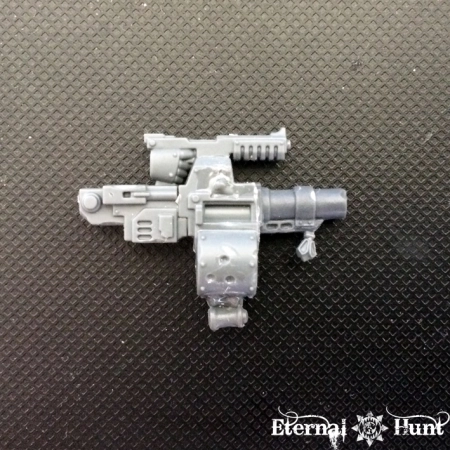
Really not brain surgery, this one: Just combine a plastic Mk. IV or Mk. III Heavy Bolter with the barrel from a Cadian grenade launcher, throw on some Nurgly bitz as needed — DONE. I cannot even claim being the first to come up with this idea, either: Credit must go to Satarin, among others.
Let me also point out that DuskRaider has made an excellent conversion for Forgeworld’s Necrosius (their aforementioned Death Guard Sorcerer) using the snapfit champion.
Poxwalkers

Now these were the other part of the new Death Guard release that I didn’t immediately fall in love with: The models just seemed too goofy and over the top to me at first. However, I’ve really grown fond of them over the last couple of weeks, so hear me out:
One reason I like them is because the amount of detail on the models is just insane, with their boils, mutations and disgusting textures rendered in a way that is almost sublime — seriously, you have to see the plastics firsthand to realise how sharp and wonderfully gross the detail on these guys is!
There’s also the fact that so much of their inherent weirdness – the strange angles of their limbs and their manic grins, for instance – gets explained really well, for once, in their background: Those are all symptoms of the disease they are suffering from, and it’s seemingly slowly turns them into something resembling nothing so much as Nurgle’s own Plaguebearers — in fact, this is an excellent callback to established background, were victims of Nurgle’s Rot originally slowly turned into Plaguebearers as well!

In another fairly cool touch, the Poxwalkers pick up on something that was already fairly excellent about the plastic Chaos cultists that came with Dark Vengeance: We get to see some remains of civilian life in the Imperium, as the tattered remains of the Poxwalkers’ clothing show their former station in life: There are miner’s suits and uniforms as well as hazmat suits — or even something that might be a medicae coat. There’s something very fitting (and disturbing) about the thought that people might have been infected while trying to fight an outbreak of the disease — or, even more sinister, while trying to engineer biological weapons? After all, this is the grimdarkness of the far future we are talking about here… 😉
A propos of nothing, let me just point out that the guy wielding what looks like a pipe wrench is actually a perfect model!
So by and large, the Poxwalkers have really managed to win me over — or should that be: get me infected? But still, some of the models are still a bit too out there, though, with features that seem a bit too exaggerated and details that are just one bridge too far. Therefore, my own approach with these models will be to prune back some of those OTT touches while keeping the models’ overall strangeness in place.
I’ve already attempted this with the Poxwalker wearing a torn hazmat suit. Here’s the result:



Now this may not seem like a huge change, but I am far more happy with the model now: Here’s what I did:
1. The oxygen tank messing up the model’s silhouette was cut off and reattached to the model’s back.
2. The hand holding the plague knife was rotated, so it looks less weird
3. On the other hand, the left arm and head were tweaked to actually make them look weirder: The disease is what mutates these guys and locks their joints at strange angles, right? Now in my imagination, the Poxwalkers’ movements should be full of weird twitching and spastic cramps — like something out of Jacob’s Ladder or Silent Hill. Which is why I carefully bent the arm to look even more unnatural. And I significantly changed the angle of the head to make it look like it too was subject to the strange cramps and spasms of the body.
As with the Plague Marines, there’s also a second, snap-fit kit of Poxwalkers available:

Yet for the most part, there’s nothing about these models that the guys in the starter kit don’t alreeady do better. The fat guy is interesting, mostly because that angle hasn’t really been explored in the first batch of Poxwalkers, and I really wish the guy with the goggles and rebreather had been included on the Dark Imperium sprues. But apart from that, these guys are really nothing to write home about.
So, all in all, I am really very happy with the Death Guard part from the Dark Imperium starter box! The Plague Marines, in particular, are a true return to form after years and years of fairly sub-par models from GW. As a starter army, these actually seem like a refined, even more interesting (if also less versatile) version of Dark Vengeance’s CSM starter force. In any case, it goes without saying that they are terrific value for the model and have really given me quite an appetite for all kinds of Nurglite shenanigans — and I am really looking forward to finally seeing the rumoured multipart kits and *gasp* the Plague Terminators! Fantastic work, gentlemen!

So what’s your take on the new Death Guard models? Are you feeling as enthusiastic about them as I am or do you have any gripes? Are there any cool conversions or additional thoughts you would like to share? I would be happy to hear from you in the comments section!
And, as always, thanks for looking and stay tuned for more!
